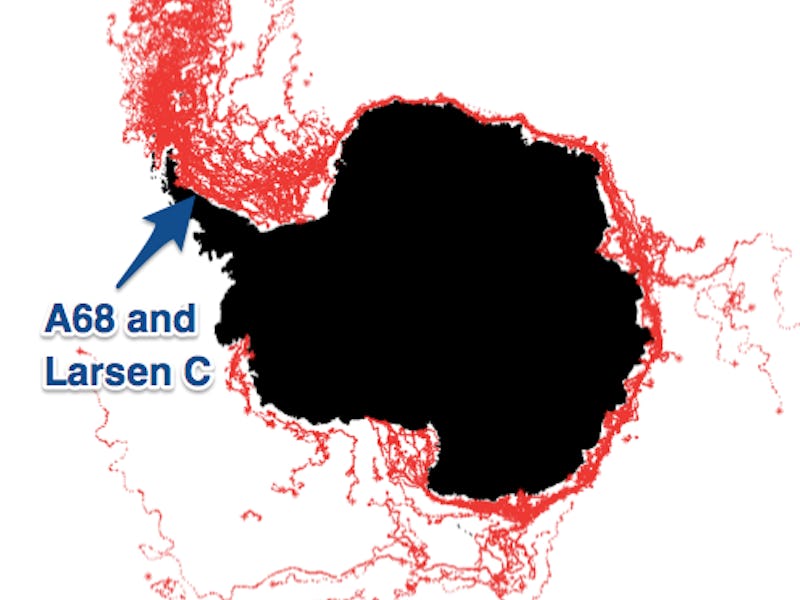Here's Where the Larsen C Iceberg Will Go Next
It has a very long journey ahead.

Last week a trillion-ton iceberg broke off the Larsen C ice shelf in Antarctica, birthing one of the largest chunks of floating ice the world has ever seen.
The ‘berg is 100 miles long and 600 feet thick — by area it’s three times the size of Maui. Next to it, the iceberg that sunk the Titanic would barely register. It was an estimated 200-400 feet long and rose 50-100 feet out of the water, according to witnesses.
The Larsen C iceberg, officially dubbed A68, could definitely makes its way into the path of shipping routes, though it’s unlikely any tankers will be caught by surprise.
“It’s incredibly unlikely that any ship would hit this ‘berg, unless they were deliberately trying to do so,” says Martin O’Leary, a scientist involved with Project MIDAS, which has been tracking the calving event in a Reddit AMA. If some captain went rogue, though, “It would be like hitting any other cliff face,” he says.
Well, yeah — the iceberg outweighs the world’s heaviest ship 1.7 million to one, even fully loaded.
“These days we track icebergs by satellite, so if they’re above a certain size they get well catalogued, and ships know to steer clear,” O’Leary says. “Smaller icebergs (too small to show up on daily satellite images) are still an issue, but most ships just avoid areas where they’re likely to be found.”
Iceberg tracks from 1999 through 2010, as compiled by Scatterometer Climate Record Pathfinder project.
What happens next for A68 is uncertain, but it is likely to drift generally to the northeast over the next few years, breaking up into smaller bits and melting slightly as it goes. Already, a small chunk has calved from the northern tip — the pair are likely to be named A68a and A68b.
Tracks from A47 and A48, two major icebergs from the Larsen B ice shelf collapse in 2002.
Major icebergs from the Larsen B collapse in 2002 floated the Weddell Sea for years. One ended its journey near South Georgia. The other went further west, closer to the Falkland Islands.
Progress of A68 and its offspring will be slow at first. The Weddell Sea is shallow, and large icebergs there often run aground. O’Leary estimates that 80-85 percent of the ‘berg is underwater — that’s 480-510 feet deep on average, with many spots likely to run much deeper. (Solid ice floats with 91 percent of its mass underwater, but icebergs contain air pockets that up their buoyancy.)
If Larsen C does collapse, it will take at least years or decades. It would increase the rate of sea level rise, because glacier ice would flow faster into the ocean. And it would change our perception of just how quickly the continent of Antarctica could fall apart.